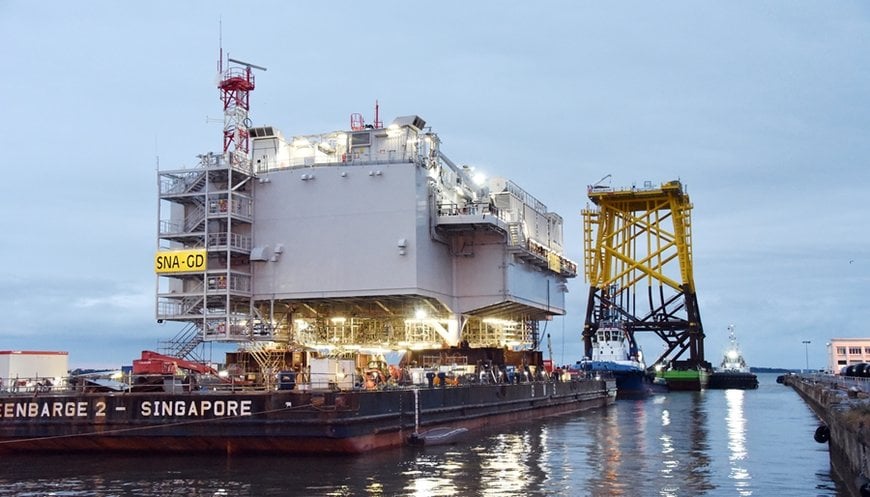Siemens to protect offshore wind farm in the French Atlantic against fire risks
The offshore wind farm in Saint-Nazaire off the Atlantic coast of France is a major project of the shipyard and energy company Chantiers de l’Atlantique. It encompasses the construction of 80 offshore wind power plants, complemented by a substation that collects and transforms the generated electricity before it is transported onshore.

Image source: Chantiers de l‘Atlantique
- Efficient fire safety for the wind farm’s fully automated substation, which is partially below the ocean surface
- Two different extinguishing systems for fire suppression optimized for specific situations
- Operation of the hard-to-reach equipment by remote control
The substation also enables remote control of the wind farm. This central element requires reliable fire protection to ensure safety and optimal operation. Siemens Smart Infrastructure supports the project with its fire detection and extinguishing solutions.
Special conditions of an extraordinary project
The planned Saint-Nazaire offshore wind farm is located about 12 km off the coast of the department of Loire-Atlantique and will comprise 80 wind power plants on an area of 78 km2. They have a capacity of 6 MW each and a total output of 480 MW. To aggregate, transform and transport the electricity generated by the wind power plants, a substation will be installed offshore. This substation, some parts of which are located 30 meters below the surface of the ocean, is fully automated. It is not staffed except for spot maintenance operations. The entire facility is expected to be completed by 2022.
“We are proud to have been entrusted with fire safety in this area,” said Henning Sandfort, CEO of Building Products at Siemens Smart Infrastructure. “Our local Siemens teams are taking care of everything from preliminary examination and planning to commissioning and training of the personnel for the automatic fire detection and extinguishing systems used for the substation, which is critical to the proper operation of the offshore park.”
Fire detection thanks to a reliable, powerful system
A fire in such a substation would have serious consequences. Detecting a fire early and extinguishing it quickly is crucial for smooth operation, especially since this station is unoccupied and difficult to access. Installing efficient and highly reliable technology is therefore essential.
Siemens Smart Infrastructure will install the FC2080 fire control panel, which is particularly suitable for critical sites such as this one. FC2080 is a multi-redundant control and detection system. In combination with ASAtechnology-based fire detectors from Siemens, this ensures early and reliable fire detection without false alarms as well as maximum availability and operational safety of the wind power plants, since it allows both direct fire damage and indirect consequences such as business interruptions to be minimized. Up to 37 modules with bus and line cards as well as I/O cards can be integrated.
Fast extinguishing without accompanying damage
The state-of-the-art fire detection system is supplemented by an automatic extinguishing system. Siemens is planning to use two different extinguishing systems for the substation, each of which will be deployed in specific situations:
- Automatic fire suppression using nitrogen: Nitrogen is a neutral inert gas that reduces the oxygen concentration and smothers the fire. This solution, which uses nitrogen gas at a pressure of 300 bar, will be installed in 23 areas of the substation. It is a simple, effective and environmentally friendly system that is harmless to humans. Most importantly, the extinguishing process does not damage the equipment, and the processes can be restarted almost immediately after an incident.
- Fire suppression using water mist: The H2O Jet solution from Siemens will be used to protect the two transformers of the substation. Its extinguishing agent, a combination of water and nitrogen, is based on water in finely distributed form. Billions of fine water droplets (50 to 200 microns) per second are sprayed into the source of the fire at very high speed (50 to 150 m/s) to quickly extinguish the fire and prevent it from reigniting. The microdroplets have a larger exchange surface and evaporate exceedingly fast (in less than 0.003 seconds).
Since the substation is difficult to access, Siemens has developed and implemented a remote-control solution for the systems. In addition, the core of the automated systems is redundant so operation can continue even if one of the components should fail.
For further information on Siemens Smart Infrastructure, please see www.siemens.com/smart-infrastructure
www.siemens.com

